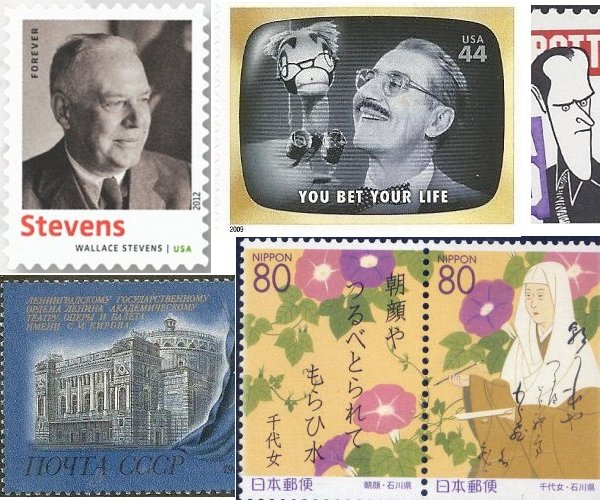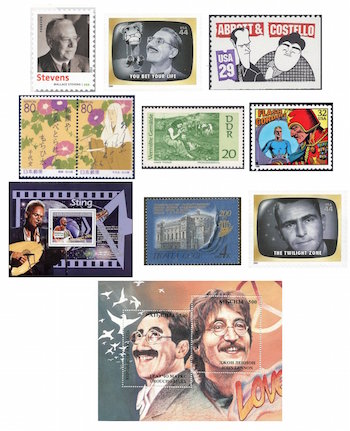The Arts on Stamps of the World —October 2
An Arts Fuse regular feature: the arts on stamps of the world.

By Doug Briscoe
Nobody has seen fit to issue a stamp in remembrance of one of the great 20th-century novelists, Graham Greene (2 October 1904 – 3 April 1991), but at least we have one for a great 20th-century poet, Wallace Stevens (October 2, 1879 – August 2, 1955). While at Harvard, Stevens had written some poetry (he and longtime friend George Santayana had shared their sonnets with each other), but Stevens did not become an established poet until much later in life. He was 35 before his first important publication in the November 1914 edition of Poetry Magazine, and he was 44 when his first book of poetry, Harmonium, appeared in 1923. He fell in love with Key West and visited often between 1922 and 1940. There he met both Robert Frost and Ernest Hemingway and had tussles with both—a couple of verbal altercations with Frost and a knock-down-drag-out with Hemingway. Apparently Stevens broke his hand smacking Papa’s jaw, but hell, who could blame him for that? (Stevens must have felt he was in the wrong, as he later apologized. He also got the worst of the exchange.) One of the poet’s most famous pieces, “Thirteen Ways of Looking at a Blackbird”, has inspired a number of musical compositions: jazz pianist Fred Hersch, Lukas Foss, Thomas Albert, Louise Talma, and the late Charles Bestor all wrote pieces based on the poem. Albert’s work was recorded by the ensemble Eighth Blackbird (the group itself took its name from the poem) on the Çedille label, and Bestor’s Piano Sonata No. 2 bears the subtitle “Thirteen Other Ways of Looking at a Blackbird”. Incidentally, Stevens’s wife Elsie was sculpted in 1913 by Adolph A. Weinman, who used the image he had made for his design of the Mercury dime minted between 1916 and 1945. (When I was a kid, it was easy to find these in your pocket change, but not for many years now. Thus the link to the picture, for you culturally deprived youngsters.)
October 2 is also the birthday of Julius Henry Marx (1890 – August 19, 1977)—Groucho Marx to you and me. Born in Manhattan, he had an uncle, Al Schoenberg (stage name Al Shean), in show business, and Julius’s mother Minnie wanted her boys to follow suit. They made thirteen features together, and Groucho appeared in as many more on his own. Later in life he scored a tremendous hit with You Bet Your Life, ostensibly a television game show, but less a game show, really, than an excuse for Groucho to exercise his priceless lightning wit. Groucho was a Gilbert and Sullivan aficionado and numbered among his good friends such diverse figures as T. S. Eliot, Carl Sandburg, Alice Cooper, Dick Cavett, and Elton John. For the Groucho stamp we revisit a 2009 sheet we’ve used here on several previous occasions, “Early [TV] Memories”, and we’ll see another stamp from that same sheet at the end of today’s piece. I’m also holding another Groucho stamp in reserve until that time…
Since we’re in the realm of film comedy, let’s turn to another practitioner of the art, William Alexander Abbott (October 2, 1897 – April 24, 1974), Bud Abbott of Abbott and Costello. He was born in New Jersey seven years to the day after Groucho, and his family was in show biz, too. Abbott produced a vaudeville show and went on the stage himself only because he couldn’t afford to pay a straight man. Abbott and Costello didn’t meet until the 1930s and performed together, doing the immortal Who’s on First? sketch, on The Kate Smith Hour in 1938. They went on to become hugely popular—and hugely reimbursed—stars. They made three dozen pictures together between 1940 and 1956, besides having their own radio and television programs. Following squabbles over salary and billing (Costello proposed renaming the act “Costello and Abbott,” but Universal Studios demurred), the pair split in 1957. Bud Abbott was married to his wife Jenny Mae Pratt for 55 years, from 1918 to his death in 1974.
Now we decidedly shift gears as we look to 18th-century Japan and a woman seen as one of the great haiku poets, Fukuda Chiyo-ni (aka Kaga no Chiyo; 1703 – 2 October 1775). Today marks the 242nd anniversary of her death. She was the daughter of a picture framer in what was then Kaga Province (now Ishikawa Prefecture) and started composing haiku at the appropriate age of 7 (appropriate because of the required number of syllables—or as the Japanese call them, on—in the second line). Within a mere ten years her precocious work was well known all over the country. She married at 18 but lost her husband two years later and subsequently became a Buddhist nun, taking the name Soen. Her most famous haiku is probably this one, as rendered in English by Patricia Donegan and Yoshie Ishibashi:
Morning glory!
the well bucket-entangled,
I ask for water.
German painter Hans Thoma (October 2, 1839 – November 7, 1924), born in the Black Forest, began as a painter of clock faces, entering the Karlsruhe Academy in 1859. Success was rather a long time in coming, an exhibition in Munich in 1870s marking the turning point, though his first truly important commission came only in 1882, when he was asked to paint five frescoes representing scenes from Wagner operas in the home of the architect Simon Ravenstein in Frankfurt. Thoma’s models were such early German masters as Albrecht Altdorfer and Lucas Cranach the Elder (whom we’ll be celebrating in a fortnight, with his son coming up sooner than that), Gustave Courbet, and nature. He was a friend of Arnold Böcklin, who also has a birthday this month. The only stamp I could unearth showing Thoma’s work happens to reproduce a painting that is (or was) lost, Spring Idyll. It comes from an East German set of stamps lamenting lost art works (though at least one of them has since been recovered). Thoma seems to have had a peculiar preoccupation with hybrid chicken-women, as we can, if we’re so inclined, see in Eight Dancing Women in Bird Bodies (1886), Siren (1892), and Bones and Skulls Lying at Your Feet in the Sand (undated). A psychology student’s thesis in the making there. But he executed many other perfectly sensible canvases, including the charming Children Dancing in a Ring (Kinderreigen, 1872). Many more can be viewed at the vast Athenaeum website.

Now a reversion to popular culture for American cartoonist Alex Raymond (October 2, 1909 – September 6, 1956), the co-creator of the Flash Gordon and Jungle Jim comic strips (both from 1934). He worked as a staff artist for the King Features Syndicate and was assigned to draw for Secret Agent X-9, which was being written by—wait for it—Dashiell Hammett! Flash Gordon, written by Don Moore, came about as the result of King Features’ desire to compete with the popular Buck Rogers strip. Raymond left his job to join the Marines during World War II, and on his return created a new character in the crime-solving Rip Kirby. Raymond was killed in a car accident at age 44. The stamp, from a 1995 sheet of popular comics (we just saw the L’il Abner stamp for Al Capp a few days back), shows Flash in the background with his nemesis the evil Emperor Ming.
The highly gifted English musician known as Sting turns 66 today. The singer, songwriter, and actor was born Gordon Matthew Thomas Sumner on 2 October 1951. He was the principal performer in the group The Police from 1977 to 1984, before going solo. We see a minisheet for him issued by the Republic of Guinea.
On October 2, 1860, a new opera and ballet house opened in St. Petersburg, Russia, to replace one that had burned down. It was called the Mariinsky (mar-YIN-ski) Theater after its imperial patroness, the Empress Maria Alexandrovna. At the time the theater boasted the largest stage in the world. The first performance given there was of Glinka’s opera A Life for the Tsar. The hall has since been renamed several times: officially today it is the State Academic Mariinsky Theater, but for most of our lives (Millennials excepted), it’s just been the Kirov. Among the works premièred there have been Mussorgsky’s Boris Godunov in 1874, Tchaikovsky’s Queen of Spades in 1890, and Khachaturian’s ballet Spartacus in 1956.
You unlock this door with the key of imagination. Beyond it is another dimension: a dimension of sound, a dimension of sight, a dimension of mind. You’re moving into a land of both shadow and substance, of things and ideas; you’ve just crossed over…into The Twilight Zone. The iconic TV program had its debut on the night of October 2, 1959. The original opening theme music was written by Bernard Herrmann. The guitar theme was composed by Marius Constant.
Around the time of the dissolution of the Soviet Union, the region of Abkhazia issued an unofficial minisheet offering a new interpretation of “Marx and Lenin”.
A graduate of the University of Massachusetts with a B.A. in English, Doug Briscoe worked in Boston classical music radio, at WCRB, WGBH, and WBUR, for about 25 years, beginning in 1977. He has the curious distinction of having succeeded Robert J. Lurtsema twice, first as host of WGBH’s weekday morning classical music program in 1993, then as host of the weekend program when Robert J.’s health failed in 2000. Doug also wrote liner notes for several of the late Gunther Schuller’s GM Recordings releases as well as program notes for the Boston Classical Orchestra. For the past few years he’s been posting a Facebook “blog” of classical music on stamps of the world, which has now been expanded to encompass all the arts for The Arts Fuse.
